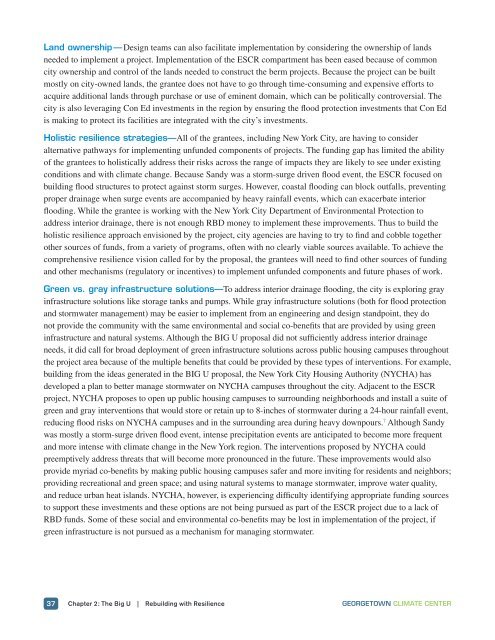Rebuilding with Resilience
dw0r306aHfX
dw0r306aHfX
Create successful ePaper yourself
Turn your PDF publications into a flip-book with our unique Google optimized e-Paper software.
Land ownership — Design teams can also facilitate implementation by considering the ownership of lands<br />
needed to implement a project. Implementation of the ESCR compartment has been eased because of common<br />
city ownership and control of the lands needed to construct the berm projects. Because the project can be built<br />
mostly on city-owned lands, the grantee does not have to go through time-consuming and expensive efforts to<br />
acquire additional lands through purchase or use of eminent domain, which can be politically controversial. The<br />
city is also leveraging Con Ed investments in the region by ensuring the flood protection investments that Con Ed<br />
is making to protect its facilities are integrated <strong>with</strong> the city’s investments.<br />
Holistic resilience strategies—All of the grantees, including New York City, are having to consider<br />
alternative pathways for implementing unfunded components of projects. The funding gap has limited the ability<br />
of the grantees to holistically address their risks across the range of impacts they are likely to see under existing<br />
conditions and <strong>with</strong> climate change. Because Sandy was a storm-surge driven flood event, the ESCR focused on<br />
building flood structures to protect against storm surges. However, coastal flooding can block outfalls, preventing<br />
proper drainage when surge events are accompanied by heavy rainfall events, which can exacerbate interior<br />
flooding. While the grantee is working <strong>with</strong> the New York City Department of Environmental Protection to<br />
address interior drainage, there is not enough RBD money to implement these improvements. Thus to build the<br />
holistic resilience approach envisioned by the project, city agencies are having to try to find and cobble together<br />
other sources of funds, from a variety of programs, often <strong>with</strong> no clearly viable sources available. To achieve the<br />
comprehensive resilience vision called for by the proposal, the grantees will need to find other sources of funding<br />
and other mechanisms (regulatory or incentives) to implement unfunded components and future phases of work.<br />
Green vs. gray infrastructure solutions—To address interior drainage flooding, the city is exploring gray<br />
infrastructure solutions like storage tanks and pumps. While gray infrastructure solutions (both for flood protection<br />
and stormwater management) may be easier to implement from an engineering and design standpoint, they do<br />
not provide the community <strong>with</strong> the same environmental and social co-benefits that are provided by using green<br />
infrastructure and natural systems. Although the BIG U proposal did not sufficiently address interior drainage<br />
needs, it did call for broad deployment of green infrastructure solutions across public housing campuses throughout<br />
the project area because of the multiple benefits that could be provided by these types of interventions. For example,<br />
building from the ideas generated in the BIG U proposal, the New York City Housing Authority (NYCHA) has<br />
developed a plan to better manage stormwater on NYCHA campuses throughout the city. Adjacent to the ESCR<br />
project, NYCHA proposes to open up public housing campuses to surrounding neighborhoods and install a suite of<br />
green and gray interventions that would store or retain up to 8-inches of stormwater during a 24-hour rainfall event,<br />
reducing flood risks on NYCHA campuses and in the surrounding area during heavy downpours. 7 Although Sandy<br />
was mostly a storm-surge driven flood event, intense precipitation events are anticipated to become more frequent<br />
and more intense <strong>with</strong> climate change in the New York region. The interventions proposed by NYCHA could<br />
preemptively address threats that will become more pronounced in the future. These improvements would also<br />
provide myriad co-benefits by making public housing campuses safer and more inviting for residents and neighbors;<br />
providing recreational and green space; and using natural systems to manage stormwater, improve water quality,<br />
and reduce urban heat islands. NYCHA, however, is experiencing difficulty identifying appropriate funding sources<br />
to support these investments and these options are not being pursued as part of the ESCR project due to a lack of<br />
RBD funds. Some of these social and environmental co-benefits may be lost in implementation of the project, if<br />
green infrastructure is not pursued as a mechanism for managing stormwater.<br />
37 Chapter 2: The Big U | <strong>Rebuilding</strong> <strong>with</strong> <strong>Resilience</strong> GEORGETOWN CLIMATE CENTER


